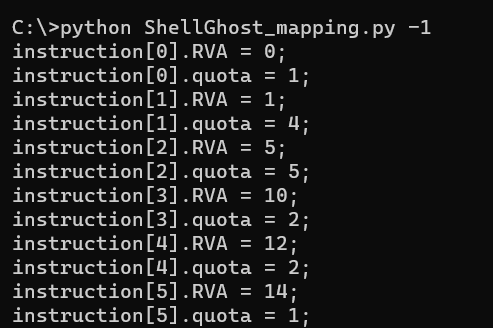
ShellGhost
A memory-based evasion technique which makes shellcode invisible from process start to end.
Handling the Thread Execution Flow
ShellGhost relies on Vectored Exception Handling in combination with software breakpoints to cyclically stop thread execution, replace the executed breakpoint with an RC4-encrypted shellcode instruction, decrypt the instruction, and resume execution after restoring memory protection to RX. When the subsequent EXCEPTION_BREAKPOINT is raised, the exception handler replaces the previous shellcode instruction with a new breakpoint so that the allocation will never disclose the complete shellcode in an unencrypted state. This happens inside a private memory page which is initially marked as READ/WRITE. Having an RW PRV allocation will not be considered an ‘Indicator of Compromise’ by memory scanners such as PE-Sieve and Moneta. When the allocation becomes RX and the page is scanned, nothing but breakpoints will be found. This happens while the shellcode is actually under execution. The following picture shows that a reverse shell is running, but no IOC is found by Moneta (other than the binary being unsigned).

Trying to scan the process with Pe-Sieve has an even better outcome:

Shellcode Mapping
Shellcode Mapping is the core functionality of ShellGhost. This tactic enables the thread to intermittently execute instructions while never exposing the entire shellcode in memory. This is possible because the position of each single shellcode instruction that the thread executes corresponds to the position of a certain breakpoint inside the allocated memory page. ShellGhost resolves this position by calculating the Relative Virtual Address (RVA) from the thread RIP to the base address of the allocated memory page and adds it to the base address of the encrypted shellcode / encrypted instructions. The number of breakpoints that will be replaced is not always the same, but it varies depending on the number of opcodes that each instruction needs to be correctly generated and interpreted (QUOTA). So for example the instruction ‘POP RBP’ is equal to ‘5D’, which means only one breakpoint will be replaced. By contrast, the instruction ‘JMP RAX’ requires opcodes ‘FF E0’, so two breakpoints will be replaced. For this reason I created the following C data structure.
Breakpoints are not immediately replaced with their instruction counterparts. This is because instructions need to undergo a decryption routine before being executed. This is where the DWORD quota comes into play. ShellGhost relies on the now popular ‘SystemFunction032’ to perform RC4 decryption. Unlike XOR, RC4 is not a single-byte encryption scheme. This means that the shellcode cannot be encrypted and decrypted all at once. This is also another reason why each instruction is treated separately. After the breakpoints are replaced, the buffer length that SystemFunction032 needs will be equal to the ‘instruction quota’, which again represents the number of opcodes the specific instruction is composed of. So for example, consider the following snippet.
We know that shellcode instruction number 5 is composed of 2 opcodes, so a buffer length of 2 will be passed to SystemFunction032. This is important because trying to decrypt the entire shellcode with a single call to SystemFunction032 will corrupt it entirely.
How is Shellcode Mapping performed?
The shellcode needs to be mapped with ShellGhost_mapping.py before compilation. The script extracts each single instruction and treats it as a small and independent shellcode. Instructions are encrypted one by one and printed out in C format all together as unsigned char. The result can be hardcoded inside the C code. Below is an example of what an encrypted MSF shellcode instructions for calc.exe looks like.

This shellcode has 98 instructions, so 98 CRYPT_BYTES_QUOTA structs are declared. When the code executes, these structs have to be populated with the proper instructions RVAs and QUOTAs. The ‘-1’ parameter instructs the mapping script to print out the piece of code that does this.

Download
Copyright (C) 2023 lem0nSec